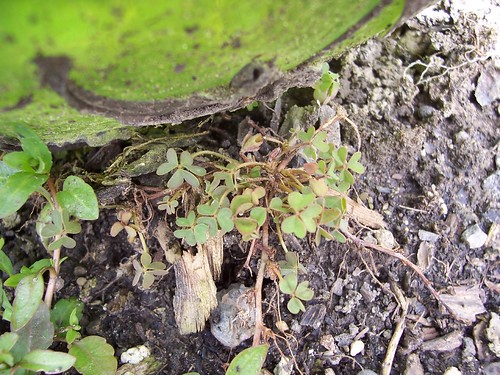Cleveland Weeds – White Clover
This is a post that relates to the Cleveland Weeds project.
In this post I am going to cover White Clover
Spring
Click on image or here to enlarge
SummerComing Soon
FallComing Soon
Latin Name: Trifolium repens
Common Names: White Clover
Lifespan: Perennial
Conditions it likes: Prefers sunny spaces that are moist but not wet and low in nitrogen and higher in phosphorus. Is most likely to be found in your lawn but can be found in garden beds as well. If you find it growing in your beds or lawn, this is a sign that your soil is low on nitrogen.
Spreading habits: Spread by seeds or creeping stems.
Best way to eliminate it from your garden:
Organic: Manually weed out from your lawn and beds remembering to remove as much of the root as possible. Improve soil quality by adding nitrogen but reduce the amount of phosphorus you add to the soil. Many weedings may need to be done before the problem is eliminated because if any roots are left, they will resprout.
Non-Organic: Apply either an herbicide or pre-emergent in the early fall. White clover seeds and plants grow in cooler weather when temperatures are between 50F – 32F so their best growth will be in the fall, early winter and early spring. It’s best to apply your chosen chemical while they are in growth mode as it will go through their system better. I don’t know about you but I find winter and early spring a miserable time to be applying anything to my yard, so applying chemicals in fall is the best time.
Notes of interest: White Clover will attract bees to your yard. If you are a gardener, you may want to opt to let it grow in your lawn so that bees will come and pollinate your flowers, vegetables and fruits.
This gardener’s rating of this weed: Annoying but tolerable due to the bee benefit.

This picture of “white clover” looks like a wild oxalis species. If the leaf has a sour bite to it then it’s definatley oxalis and not white clover. White clover is also edible. This plant also looks like it is slightly succulent which is another characteristic of oxalis.
Of course, you will know for sure when it flowers.
One of the benefits of clover is that it is a nitrogen fixing plant which will organically repair the nitrogen deficit and benefit your garden as a ground cover, in addition to being beneficial to the bees. For some reason we just don’t like to see it there.
The photo is definitely an Oxalis. As they’ve got the 3 leaflets and are found in lawns, they’re often confused with cover. That the shops sell pots of Oxalis as “shamrocks” for St. Patrick’s Day makes them even more often confused for each other. (Shamrocks are from the clover family, though exactly which clover is much debated.)
I don’t see why anyone would object to allowing white clover to bloom in their lawn, but then I don’t see why anyone would favor spreading chemicals to maintain a lawn.
My own rather vast grassy area (I call it a lawn right around the house and a field farther off) is maintained through decades of mowing what offers itself. I do not know what the former owners did to establish any of the grasses. I live in the southeast, and over the two decades that I have lived here my basic mowing philosophy has jokingly been “kill.” In the fast-growing season, I’m out mowing various areas almost daily, and I cut it pretty short. In that way, I have maintained a fairly decent lawn area that apparently can withstand any drought and make a good, healthy comeback when the drought ends.
Right now, large areas of my lawn are white with clover heads and densely green under them with the small clover leaves. I am refraining from my usual mowing plan while I study the situation. The reason: Until now (May 17) I have seen NO BEES of any variety except the carpenter bees. And I’ve been looking. I have many, many flowering plants, and normally bees should be everywhere. I can recall earlier springs with tens of thousands of the small black wild bees working, their buzz filling the air along with the heavy scent of all the blossoms. No one around here keeps Italian honey bees, so the wild bees are what I have.
Now, in the last few days, I have found first just a couple of bees, and now quite a few, working on … the white clover.
We all must know the bee die-off has been notable and alarming in the past couple of years. The bees I’m seeing in the last few days are not on the honeysuckle or any of my garden flowers. They are on the clover. I’m going to let them have the clover, and I won’t be cutting it until I see them strongly working other types of blooms.
I’d welcome any followup comments and especially observations/expertise about the bee situation in other places.
I get this from my farmer-dad,”I don’t care what is growing (on the lawn), as long as it’s green.” I don’t fertilize or pesticize and am rewarded with limited mowing demands. This year, the white clover is taking over and I’ve always thought that to be a good thing–no mowing needed, in addition to the nitrogen-fixing and honey bee plusses. Now, they are flowering and I find Judith Ann Johnson having the same concern as mine: no honey bees! I just did a patrol and did find a nice little bumble bee though (on 1/4 acre of clover) and hope he spreads the word. I share the concern that the honey bees are in trouble world wide. My white clover wants to help them out!